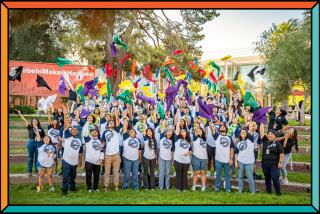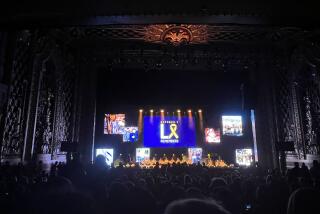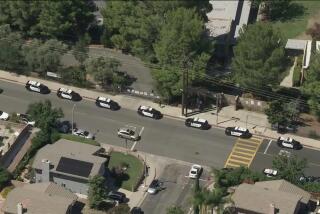Teens Gather to Give Peace a Chance
- Share via
GLENDALE — In typical teenage fashion, the conversations at a youth-oriented peace conference Saturday flowed easily from topics as disparate as Aerosmith concerts and the mall, to Columbine High School and gang violence.
The event, the third annual conference sponsored by Glendale-based We Care for Youth, was planned long before the tragic shootings in Colorado last month had again focused the nation’s attention on violent teens.
That rampage, in which two teens killed 13 people before taking their own lives, came up several times as panelists--many who have been victims or perpetrators of violence--sought to help the young audience understand the lethal byproduct of guns and anger.
And while several students said they thought such a tragedy could occur anywhere, even at Glendale High where the event was held, most focused on the street violence that has become all too common closer to home.
“I know a lot of people that are in gangs,” said 13-year-old Pamela Chaires, who hopes to become an archeologist. “Most of them got shot, some three times. They’ve been in jail.”
Pamela and friends Ardis Cole, 13, and 12-year-old Jackie Remery--all seventh-graders at Wilson Middle School in Glendale--were among the youngest participants in the conference, which attracted more than 100 teens and preteens from middle and high schools throughout Glendale, as well as select programs in Los Angeles.
Like many of the students, the three said they’ve seen the effects of street violence up close. They are hopeful they can make a difference, but are not naive about the size of the problem.
Los Angeles County Dist. Atty. Gil Garcetti, who described himself as the son of a former gang member, said one key to addressing the problem is “to empower the kids so that they can do something on their own campuses.”
Garcetti, who said he was beaten by gang members as a seventh-grader, acknowledged the conference may in part be preaching to the choir.
“This [conference] may be more of a leadership group and activist leaders than troublemakers,” said Garcetti of the participants.
The hope is that those students can reach others, he said.
“We have to learn how to empower them [students] so that they have a safer environment,” he said.
With presentations ranging from the typical scared-straight approach to sessions focusing on the power of poetry, the day was designed to give youth strategies for defusing tensions and reasons for avoiding street life.
Although much of the program was gender-neutral, several speakers emphasized that violence affects girls as well as the homeboys.
Among those at the conference were 19 female juvenile offenders, all under age 20, from Camp Joseph Scott in Saugus. Some spoke on the effects of violence in their lives.
On another panel, 22-year-old Patricia Madison said she hoped some of the students would learn from her example.
Always in fights, Madison said she has stolen cars, spent time in jail, been shot and abused drugs. She also cited alcohol-induced blackouts.
All in all, she said, it’s not the kind of lifestyle choice she would recommend.
“More than 10 of my homeboys died,” said Madison, a mother of two girls. She recently completed high school and is trying to turn her life around. “I never knew it cost so much to bury someone. And nobody thinks about that,” she said.
Wheelchair user Fidel Valenzuela, whose Project PEACE speakers’ bureau works with youths to reduce violence, said, “Girls get shot too. You’ve got girls that were paralyzed just by running away.
“We have paid a price,” added Valenzuela, who uses a wheelchair because of the toll drugs took on his body. He said gunshot wounds, one from a drive-by shooting, put two of his fellow speakers in wheelchairs.
“We don’t want to see you end up in the hospital, to see your parents crying over you . . .,” Valenzuela said.
Although reaction to the speakers was generally positive, many of the youths expressed an attitude that seemed to straddle the line between bravura and fatalism.
“If your time comes your time comes,” Pamela said. “We can try to prevent it, but you never know. It just happens, you can’t live your life in fear.”
Looking toward the future, Pamela, Ardis and Jackie all said they expect violence to continue to be a part of their reality during their teen years.
“It’s never going to go away,” Pamela said. “We’re the future, and we’re going to try as much as we can, but it’ll never go away.
“Not everyone is like us, coming to these peace conferences.”
More to Read
Sign up for Essential California
The most important California stories and recommendations in your inbox every morning.
You may occasionally receive promotional content from the Los Angeles Times.










